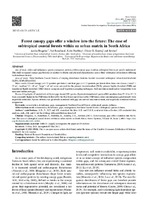| dc.contributor.author | Bhugeloo, Astika | |
| dc.contributor.author | Ramdhani, Syd | |
| dc.contributor.author | Sershen | |
| dc.date.accessioned | 2022-02-14T10:27:07Z | |
| dc.date.available | 2022-02-14T10:27:07Z | |
| dc.date.issued | 2021 | |
| dc.identifier.citation | Bhugeloo, A. et al. (2021). Forest canopy gaps offer a window into the future: The case of subtropical coastal forests within an urban matrix in South Africa. Forest Systems 30 (1), e003. 10.5424/fs/2021301-16914 | en_US |
| dc.identifier.issn | 2171-9845 | |
| dc.identifier.uri | 10.5424/fs/2021301-16914 | |
| dc.identifier.uri | http://hdl.handle.net/10566/7247 | |
| dc.description.abstract | Alien and indigenous species emergence patterns within canopy gaps in urban subtropical forests are poorly understood.
This study compared canopy gap floristics in relation to abiotic and physical characteristics across three subtropical urban forests differing
in disturbance history. : Three Northern Coastal Forests of varying disturbance histories located in coastal subtropical urban KwaZulu-Natal
(KZN), South Africa (SA). Closed canopy (n = 15 quadrats per forest ) and four gaps (n = 12 quadrats per forest) from three size classes (‘small’ <
25 m2
, ‘medium’ 25 - 45 m2
; ‘large’ > 45 m2
) were surveyed for the primary least disturbed (PLD), primary highly disturbed (PHD) and
transitional highly disturbed (THD) forests using classical vegetation sampling techniques. Soil moisture content and air temperature were
measured within each gap. | en_US |
| dc.language.iso | en | en_US |
| dc.publisher | INST NACIONAL INVESTIGACION TECHNOLOGIA AGRARIA ALIMENTARIA | en_US |
| dc.subject | species richness | en_US |
| dc.subject | Alien | en_US |
| dc.subject | South Africa | en_US |
| dc.subject | Northern Coastal forest | en_US |
| dc.title | Forest canopy gaps offer a window into the future: The case of subtropical coastal forests within an urban matrix in South Africa | en_US |
| dc.type | Article | en_US |

